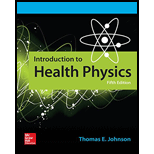
Concept explainers
(a)
The minimum thickness of the paraffin shield.
(a)
Answer to Problem 10.1P
The minimum thickness of the paraffin shield is 44 cm.
Explanation of Solution
Given:
Source emits,
The fast neutron flux,
Attenuation coefficient,
Build up factor for hydrogenous shields, B = 5
Formula used:
Where,
t = thickness of paraffin shield
Calculation:
The shield's surface
Using the method of iteration,
First, we assume a small value of t, and then calculating the resulting value
Conclusion:
Att = 44 cm results in
(b)
Thermal neutron leakage atthe surface of the field.
(b)
Answer to Problem 10.1P
The thermal neutron leakage is
Explanation of Solution
Given:
Point source emit, S = 107 n/sec
Radius, R = 44 cm
Diffusion coefficient, D = 0.381 cm
thermal diffusion length, L = 3cm
Formula used:
The thermal neutron leakage
Calculation:
The thermal neutron leakage:
Conclusion:
The thermal neutron leakage is
(c)
The gamma ray dose rate, due to the hydrogen capture gammas, atthe surface of the shield.
(c)
Answer to Problem 10.1P
Explanation of Solution
Given:
Point source emit, S = 107 n/sec
Radius, R = 44 cm
The flux of fast neutron,
The flux of thermal neutron,
Formula used:
The concentration of gamma emitter
The source strength
Where,
fi = fraction of the transformations that yield a photon of the ith energy, and
Ei = energy of the ith photon, MeV
Where,
The dose rate :
Calculation:
Concentration of gamma emitter
The source strength
Linear energy absorption coefficient for paraffin
Inserting these values into the dose rate equation, we have
Conclusion:
Gamma ray dose rate is
Want to see more full solutions like this?
- Estimate the probability that nuclear reactor-produced electronic antineutrino has an interaction with a proton when traversing the earth. Cross section for antineutrino interacting with a proton is 10-43 cm² , mean earth radius is 6.37x108 cm, and mean mass density of the Earth is 5.52 g/cm°. Use 10 decimal places for the answer. Hint: Approximate Earth as iron.arrow_forwardFor neutron moderation by helium, make a sketch showing the average energy of a beam of initial 2.0 MeV neutrons as a function of time, assuming the mean time between collisions is t. How long does it take for the neutrons to loose 50% of their energy? How long for 90%?arrow_forwardThe cross section for neutrons of energy 10 eV being captured by silver (p = 10.5 g/cm3) is 17 barns. What is the probability of a neutron being captured as it passes through a layer of silver 2 mm thick?arrow_forward
- Consider a fi nite square-well potential well of width 3.00 x 10-15 m that contains a particle of mass 1.88 GeV/c2. How deep does this potential well need to be to contain three energy levels? (This situation approximates a deuteron inside a nucleus.)arrow_forwardA single neutron confined inside a nucleus has a minimum kinetic energy Kmin consider it to be a cube of volume a³. Give your answer to 2 significant figures in units of fm. (fm femtometers = 10 15 m) 20 MeV. Find the size a of the nucleus if we Formulas.pdf (Click here-->)arrow_forwardEstimate the minimum frequency of a y-ray that causes a deuteron to disintegrate into a proton and a neutron, commenting on any assumptions you make. The masses of the particles are 2.0141m, m, = 1.0078m., m, = 1.0087m.. %3!arrow_forward
- A 5 MeV α particle approach a gold nucleus with an impact parameter of 2.6 ×10−13 meter. Through what angle will it be scattered.arrow_forwardwhat is the range of a 10 MeV proton in air at 10 Atm ( in mm ) ? Please use the above unit ( mm ) to solve this problemarrow_forward: Evaluate the electron Debye length and number of particles for A laser fusion , electron beam fusion , with T = 1K eV , n = 1020 cm−3.arrow_forward
- In a neutron-activation experiment, a flux of 108 neutrons/cm2sec is incident normally on a foil of area 1 cm?, density 1022 atoms/cm3 , and thickness 10-2 cm. The target nuclei have a total cross section for neutron capture of 1 barn (10-24 cm2), Find the number of b ( the light particle) per second ? 104 particle/sec 102 particle/sec 106 particle/sec 108 particle/sec Clear my choicearrow_forwardEstimate the probability that nuclear reactor-produced electronic antineutrino has an interaction with a proton when traversing the earth. Cross section for antineutrino interacting with a proton is 10 43 cm2, mean earth radius is 6.37x108 cm, and mean mass density of the Earth is 5.52 g/cm. Use 10 decimal places for the answer. Hint: Approximate Earth as iron. Your Answer: Answerarrow_forwardWhat is the ratio of the velocity of a 5.00-MeV β ray to that of an α particle with the same kinetic energy? This should confirm that β s travel much faster than α s even when relativity is taken into consideration.arrow_forward
 Modern PhysicsPhysicsISBN:9781111794378Author:Raymond A. Serway, Clement J. Moses, Curt A. MoyerPublisher:Cengage Learning
Modern PhysicsPhysicsISBN:9781111794378Author:Raymond A. Serway, Clement J. Moses, Curt A. MoyerPublisher:Cengage Learning Classical Dynamics of Particles and SystemsPhysicsISBN:9780534408961Author:Stephen T. Thornton, Jerry B. MarionPublisher:Cengage Learning
Classical Dynamics of Particles and SystemsPhysicsISBN:9780534408961Author:Stephen T. Thornton, Jerry B. MarionPublisher:Cengage Learning

